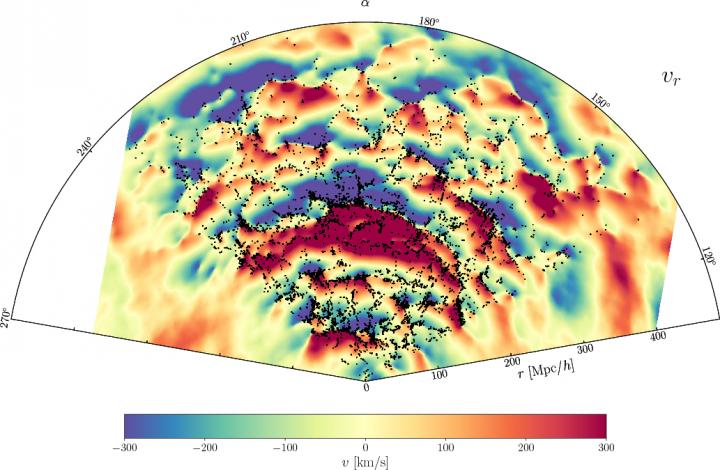Jul 26 2017
New maps of dark matter dynamics in the Universe have been produced by a team of international cosmologists.
 Slice through the celestial equator showing the radial component of the velocity field (in kilometres per second). Blue regions are falling towards us and red regions are flying away from us. Galaxies of the Sloan Digital Sky Survey main galaxy sample are overplotted. In the centre of the slice, the infalling dynamics of the Sloan Great Wall, one of the largest structure of the known Universe, can be observed. (Credit: University of Portsmouth)
Slice through the celestial equator showing the radial component of the velocity field (in kilometres per second). Blue regions are falling towards us and red regions are flying away from us. Galaxies of the Sloan Digital Sky Survey main galaxy sample are overplotted. In the centre of the slice, the infalling dynamics of the Sloan Great Wall, one of the largest structure of the known Universe, can be observed. (Credit: University of Portsmouth)
Using advanced computer modelling techniques, the research team has translated the distribution of galaxies into detailed maps of matter streams and velocities for the first time.
The research was carried out by leading cosmologists from the UK, France and Germany.
Dr Florent Leclercq from the University of Portsmouth's Institute of Cosmology and Gravitation said: "Dark matter is a substance of yet unknown nature that scientists believe makes up more than 80 per cent of the total mass of the Universe. As it does not emit or react to light, its distribution and evolution are not directly observable and have to be inferred."
The researchers used legacy survey data obtained during 2000 -- 2008 from the Sloan Digital Sky Survey (SDSS), a major three-dimensional survey of the Universe. The survey has deep multi-colour images of one fifth of the sky and spectra for more than 900,000 galaxies. The new dark matter maps cover the Northern Sky up to a distance of 600 megaparsecs, which is the equivalent of looking back about two billion years.
The researchers used a set of phase-space analysis tools and built on research from 2015, which reconstructed the initial conditions of the nearby Universe.
Dr Leclercq said: "Adopting a phase-space approach discloses a wealth of information, which was previously only analysed in simulations and thought to be inaccessible using observations.
"Accessing this information in galaxy surveys opens up new ways of assessing the validity of theoretical models in light of observations."
The research is published in the Journal of Cosmology and Astroparticle Physics.